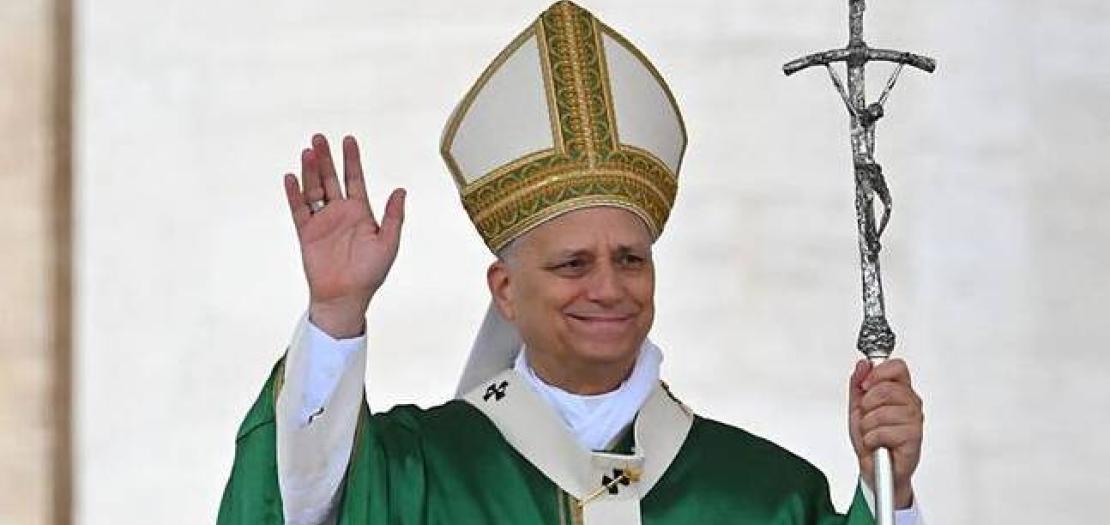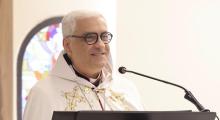Issued by the Catholic Center for Studies and Media - Jordan. Editor-in-chief Fr. Rif'at Bader - موقع أبونا abouna.org

The countdown to the hopeful encounter has begun. From the Vatican, His Holiness Pope Leo XIV carries his peace to Lebanon, which awaits him with longing and faith. The Holy Father comes to the Land of the Cedars for a historic visit, one for which the Lebanese are preparing with hearts full of joy and Prayer.
The visit of His Holiness Pope Leo XIV, under the motto "Blessed Are the Peacemakers," is a sign of hope in a time when Lebanon is experiencing difficult circumstances. It is a visit that will confirm that the light of Christ truly dispels worldly darkness.
As the anticipated date draws near, Church, security, and logistical preparations are in full swing to ensure the Pope's arrival in Lebanon between November 30 and December 2.
The Pope's program in Lebanon includes several stations where he will unite with the Lebanese people in Prayer for peace, justice and truth and righteousness, and for all humanity on this earth. What is remarkable about his program is his visit to the Shrine of Saint Charbel in the Monastery of Saint Maron in Annaya, the Shrine of Our Lady of Lebanon in Harissa, and the Sisters of the Cross Hospital in Jal El Dib. These three sites hold within their walls a rich history of faith, service, and love.
Monastery of Saint Maron in Annaya
The idea for the Monastery of Saint Maron in Annaya arose in 1820 with a decision by the Lebanese Maronite Order, and its construction began in 1828, the year of Saint Charbel's birth. In 1829, the Monastery was founded, with Father Sarkis Kartabawi serving as its first Abbot, followed by Father Youhanna Al-Kaakouri.
Other historical stations were also witnessed at the Monastery. In 1838, Father Emmanuel Al-Chababi was elected Abbot General, and decided with his Council of Administrators to continue the Monastery's construction, choosing Father Libaous Al-Tannouri as its Head. On May 8, 1839, construction work was completed, and it continued until October 20, 1841.
In 1965, Charbel Makhlouf was beatified, and the Lebanese Maronite Order built a new Church to accommodate more pilgrims visiting Annaya. In 1974, the new Church, dedicated to Saint Charbel, was consecrated west of the Monastery.
It is worth noting that the Monastery of Saint Maron in Annaya has become a global pilgrimage site, attracting thousands from all regions and countries around the world to pray before the Shrine of Saint Charbel, seeking inner peace and divine blessings.
The Shrine of Our Lady of Lebanon in Harissa
The idea for the Shrine of Our Lady of Lebanon was born during the fiftieth anniversary of the Feast of the Immaculate Conception. Maronite Patriarch Elias Howayek and Apostolic Delegate Bishop Carlos Duval decided to create a Religious monument to commemorate this occasion. Thus, it was decided to build a large statue of the Virgin Mary bearing the title "Our Lady of Lebanon" on the Shrine, as a sign of the Lebanese people's veneration of the Virgin Mary.
The foundation stone was laid in October 1904 at a site called "Al Sakhra" (The Rock) located on the summit of Harissa Hill. Patriarch Howayek entrusted Ibrahim Makhlouf with the project's execution, and the Church and the statue's pedestal were completed in 1907. The cost of building the Church and the statue was approximately 50,000 gold francs.
The Church is crowned by a large statue of Mary, Mother of God and Our Lady of the Immaculate Conception. It includes a square stone Altar, next to which stands a statue of the Virgin Mary, Mother of Light, made of cedar wood. There is also a tabernacle carved with a cedar tree and a cross above clusters of grapes. The statue of Our Lady of Lebanon was made of bronze in a workshop in Lyon, France. It is eight and a half meters tall, five meters in diameter, and weighs 15 tons.
On May 31, 1970, the foundation stone of the Basilica of Our Lady of Lebanon was laid by the Maronite Patriarch Paul Peter Meouchi, in response to the need for a large Church to accommodate large crowds of worshippers. The Basilica's design was inspired by the shape of the Lebanese cedar tree and the Phoenician ship.
Throughout history, the Shrine of Our Lady of Lebanon in Harissa has been an oasis of faith and hope, a refuge in times of hardship and adversity, and a meeting place for all Denominations and Religions.
Sisters of the Cross Hospital – Jal El Dib
"Human happiness lies not in the wealth one possesses, but in the good one does." These words of Blessed Father Yaacoub the Capuchin were not mere pronouncements, but were embodied in action through service, giving, and love for all people.
Father Yaacoub the Capuchin founded the Monastery of the Cross in 1919, transforming it into a hospice in 1937. In 1951, he established the Hospital of the Cross for Mental and Psychological Illnesses, which strives to serve all people without Religious, ethnic, or cultural discrimination.
Father Yaacoub wanted the Monastery to bear the name of the Cross because the Cross was the cornerstone of his heart, and in it he found his peace and pride. From here, he taught the Sisters of the Cross to direct their Prayers toward the Crucified One and their service toward all humanity.
The Hospital of the Cross welcomes patients throughout the year and serves as a refuge for the abandoned and oppressed, a beacon of hope for those suffering emotionally and mentally, where the Sisters of the Cross heal their wounds and embrace them with great joy and profound love.
This is the love that His Holiness Pope Leo XIV wants to reflect in Lebanon by sowing the seeds of peace and hope in a land yearning for true peace and a healthy future filled with comfort, tranquility, and stability. But what comes after this historic visit?







